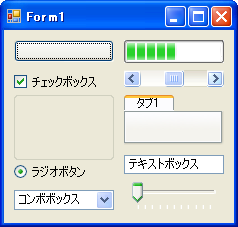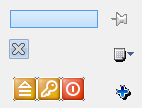注意:ここで紹介している方法は、.NET Framework 2.0以降でのみ使用できます。
注意:画像の表示方法が分からないという方は、まず「コントロールやフォームに画像を表示する」をご覧ください。
コントロールを描画する方法は「コントロールを描画する」で説明しましたが、ここではコントロールをvisualスタイルで描画する方法を紹介します。
「(コントロール名)Renderer」という名前のクラスを使うことで、コントロールをvisualスタイルで描画できます。このようなクラスを表にすると、以下のようになります。
| コントロール | 描画に使用するクラス | 補足 |
|---|---|---|
| Button | ButtonRendererクラス | RenderMatchingApplicationStateプロパティをTrueにすることにより、アプリケーションのvisualスタイルが無効な場合でもvisualスタイルで描画される |
| CheckBox | CheckBoxRendererクラス | RenderMatchingApplicationStateプロパティをTrueにすることにより、アプリケーションのvisualスタイルが無効な場合でもvisualスタイルで描画される |
| GroupBox | GroupBoxRendererクラス | RenderMatchingApplicationStateプロパティをTrueにすることにより、アプリケーションのvisualスタイルが無効な場合でもvisualスタイルで描画される |
| RadioButton | RadioButtonRendererクラス | RenderMatchingApplicationStateプロパティをTrueにすることにより、アプリケーションのvisualスタイルが無効な場合でもvisualスタイルで描画される |
| ComboBox | ComboBoxRendererクラス | visualスタイルが無効な場合に例外をスロー |
| ProgressBar | ProgressBarRendererクラス | visualスタイルが無効な場合に例外をスロー |
| ScrollBar | ScrollBarRendererクラス | visualスタイルが無効な場合に例外をスロー |
| Tab | TabRendererクラス | visualスタイルが無効な場合に例外をスロー |
| TextBox | TextBoxRendererクラス | visualスタイルが無効な場合に例外をスロー |
| TrackBar | TrackBarRendererクラス | visualスタイルが無効な場合に例外をスロー |
上の表で「visualスタイルが無効な場合に例外をスロー」と書かれているクラスは、visualスタイルが無効な場合(OSがサポートしていないか、ユーザーが無効にしているか、アプリケーションウィンドウのクライアント領域に適用されていない場合)に使用すると、例外InvalidOperationExceptionをスローします。「RenderMatchingApplicationStateプロパティをTrueにすることにより...」と書かれているクラスは、visualスタイルが無効な場合(前記条件に加え、現在のアプリケーションにvisualスタイルが適用されていない場合)に使用すると、クラシックスタイルで描画されます。さらにこれらのクラスのRenderMatchingApplicationStateプロパティをTrueにすると、visualスタイルが無効な場合でもvisualスタイルで描画されます。
visualスタイルが無効な場合に例外をスローするクラスでは、そのクラスのIsSupportedプロパティを使ってそのクラスが使用できるか確認できます。
補足:OSがvisualスタイルをサポートしているかを調べるには、VisualStyleInformation.IsSupportedByOSプロパティがTrueを返すか調べます。ユーザーがvisualスタイルを有効にしているかを調べるには、VisualStyleInformation.IsEnabledByUserプロパティがTrueを返すか調べます。アプリケーションウィンドウのクライアント領域にvisualスタイルが使用されているか調べるには、Application.VisualStyleStateプロパティにVisualStyleState.ClientAreaEnabledかVisualStyleState.ClientAndNonClientAreasEnabledが設定されているかを調べます。
これら3つがすべて有効かを調べるには、VisualStyleRenderer.IsSupportedプロパティがTrueを返すか調べます。
これら3つがすべて有効で、さらに現在のアプリケーションにvisualスタイルが適用されているか調べるには、Application.RenderWithVisualStylesプロパティがTrueを返すか調べます。
以下にこれらのクラスを使ってコントロールを描画する例を示します。ここでは、ピクチャボックスである"PictureBox1"に描画しています。
'Imports System.Drawing 'Imports System.Windows.Forms '描画先とするImageオブジェクトを作成する Dim canvas As New Bitmap(PictureBox1.Width, PictureBox1.Height) 'ImageオブジェクトのGraphicsオブジェクトを作成する Dim g As Graphics = Graphics.FromImage(canvas) 'ボタンコントロールを描画する Dim butonRect As New Rectangle(10, 10, 100, 22) '背景を描画 ButtonRenderer.DrawParentBackground(g, butonRect, PictureBox1) 'フォーカスを描画し、普通の状態とする ButtonRenderer.DrawButton(g, butonRect, PictureBox1.Text, PictureBox1.Font, _ True, System.Windows.Forms.VisualStyles.PushButtonState.Normal) 'チェックボックスを描画する '大きさと位置を計算 Dim checkBoxRect As New Rectangle(10, 40, 100, 24) Dim checkBoxLocation As New Point(checkBoxRect.X, _ checkBoxRect.Y + (checkBoxRect.Height - 13) / 2) Dim checkBoxTextRect As New Rectangle(checkBoxRect.X + 16, checkBoxRect.Y, _ checkBoxRect.Width - 16, checkBoxRect.Height) 'テキストの表示法 Dim checkBoxTextFormat As TextFormatFlags = _ TextFormatFlags.Left Or TextFormatFlags.VerticalCenter 'チェックされた普通の状態とする CheckBoxRenderer.DrawCheckBox(g, checkBoxLocation, checkBoxTextRect, _ "チェックボックス", PictureBox1.Font, checkBoxTextFormat, False, _ System.Windows.Forms.VisualStyles.CheckBoxState.CheckedNormal) 'グループボックスを描画する GroupBoxRenderer.DrawGroupBox(g, New Rectangle(10, 65, 100, 65), _ System.Windows.Forms.VisualStyles.GroupBoxState.Normal) 'ラジオボタンを描画する '大きさと位置を計算 Dim radioButtonRect As New Rectangle(10, 130, 100, 24) Dim radioButtonLocation As New Point(radioButtonRect.X, _ radioButtonRect.Y + (radioButtonRect.Height - 13) / 2) Dim radioButtonTextRect As New Rectangle(radioButtonRect.X + 16, _ radioButtonRect.Y, radioButtonRect.Width - 16, radioButtonRect.Height) 'テキストの表示法 Dim radioButtonTextFormat As TextFormatFlags = _ TextFormatFlags.Left Or TextFormatFlags.VerticalCenter 'チェックされた普通の状態とする RadioButtonRenderer.DrawRadioButton(g, radioButtonLocation, _ radioButtonTextRect, "ラジオボタン", PictureBox1.Font, _ radioButtonTextFormat, False, _ System.Windows.Forms.VisualStyles.RadioButtonState.CheckedNormal) 'コンボボックスを描画する If ComboBoxRenderer.IsSupported Then '大きさと位置を計算 Dim comboBoxRect As New Rectangle(10, 160, 100, 20) Dim comboBoxButtonRect As New Rectangle( _ comboBoxRect.X + comboBoxRect.Width - 18, comboBoxRect.Y + 1, _ 17, comboBoxRect.Height - 2) 'テキストの表示法 Dim comboBoxTextFormat As TextFormatFlags = TextFormatFlags.TextBoxControl 'テキストボックスの描画 ComboBoxRenderer.DrawTextBox(g, comboBoxRect, "コンボボックス", _ PictureBox1.Font, comboBoxTextFormat, _ System.Windows.Forms.VisualStyles.ComboBoxState.Normal) 'ドロップダウンボタンの描画 ComboBoxRenderer.DrawDropDownButton(g, comboBoxButtonRect, _ System.Windows.Forms.VisualStyles.ComboBoxState.Normal) End If 'プログレスバーバーを描画する If ProgressBarRenderer.IsSupported Then '大きさと位置を計算 Dim progressBarRect As New Rectangle(120, 10, 100, 23) Dim progressBarChunksRect As New Rectangle(progressBarRect.X + 3, _ progressBarRect.Y + 3, 50, progressBarRect.Height - 6) '空のプログレスバーバーを描画 ProgressBarRenderer.DrawHorizontalBar(g, progressBarRect) 'プログレスバーバーの中身を描画 ProgressBarRenderer.DrawHorizontalChunks(g, progressBarChunksRect) End If 'スクロールバーを描画する If ScrollBarRenderer.IsSupported Then Dim scrollBarRect As New Rectangle(120, 40, 100, 17) 'トラックの描画 ScrollBarRenderer.DrawLeftHorizontalTrack(g, _ New Rectangle(scrollBarRect.X, scrollBarRect.Y, 50, _ scrollBarRect.Height), _ System.Windows.Forms.VisualStyles.ScrollBarState.Normal) ScrollBarRenderer.DrawRightHorizontalTrack(g, _ New Rectangle(scrollBarRect.X + 50, scrollBarRect.Y, _ 50, scrollBarRect.Height), _ System.Windows.Forms.VisualStyles.ScrollBarState.Pressed) 'つまみの描画 ScrollBarRenderer.DrawHorizontalThumb(g, _ New Rectangle(scrollBarRect.X + 40, scrollBarRect.Y, _ 20, scrollBarRect.Height), _ System.Windows.Forms.VisualStyles.ScrollBarState.Normal) 'つまみのグリップを描画 ScrollBarRenderer.DrawHorizontalThumbGrip(g, _ New Rectangle(scrollBarRect.X + 40, scrollBarRect.Y, _ 20, scrollBarRect.Height), _ System.Windows.Forms.VisualStyles.ScrollBarState.Normal) '矢印ボタンの描画 ScrollBarRenderer.DrawArrowButton(g, _ New Rectangle(scrollBarRect.X, scrollBarRect.Y, _ 17, scrollBarRect.Height), _ System.Windows.Forms.VisualStyles.ScrollBarArrowButtonState.LeftNormal) ScrollBarRenderer.DrawArrowButton(g, _ New Rectangle(scrollBarRect.X + scrollBarRect.Width - 17, _ scrollBarRect.Y, 17, scrollBarRect.Height), _ System.Windows.Forms.VisualStyles.ScrollBarArrowButtonState.RightHot) End If 'タブを描画する If TabRenderer.IsSupported Then '大きさと位置を計算 Dim tabRect As New Rectangle(120, 65, 100, 50) Dim tabItemRect As New Rectangle(tabRect.X, tabRect.Y, 50, 16) Dim tabPageRect As New Rectangle( _ tabRect.X, tabRect.Y + tabItemRect.Height, tabRect.Width, _ tabRect.Height - tabItemRect.Height) 'タブページの描画 TabRenderer.DrawTabPage(g, tabPageRect) 'タブアイテムの描画 TabRenderer.DrawTabItem(g, tabItemRect, "タブ1", PictureBox1.Font, False, _ System.Windows.Forms.VisualStyles.TabItemState.Selected) End If 'テキストボックスを描画する If TextBoxRenderer.IsSupported Then Dim textBoxRect As New Rectangle(120, 125, 100, 19) Dim textBoxFormat As TextFormatFlags = TextFormatFlags.TextBoxControl TextBoxRenderer.DrawTextBox(g, textBoxRect, "テキストボックス", _ PictureBox1.Font, textBoxFormat, _ System.Windows.Forms.VisualStyles.TextBoxState.Normal) End If 'トラックバーを描画する If TrackBarRenderer.IsSupported Then '大きさと位置を計算 Dim trackBarRect As New Rectangle(120, 150, 100, 5) Dim trackBarTrackRect As New Rectangle( _ trackBarRect.X + 8, trackBarRect.Y + 10, trackBarRect.Width - 16, 4) Dim trackBarTicksRect As New Rectangle( _ trackBarRect.X + 13, trackBarRect.Y + 25, trackBarRect.Width - 26, 4) Dim trackBarThumbRect As New Rectangle( _ trackBarRect.X + 8, trackBarRect.Y + 2, 11, 21) 'トラックの描画 TrackBarRenderer.DrawHorizontalTrack(g, trackBarTrackRect) '目盛りの描画 TrackBarRenderer.DrawHorizontalTicks(g, trackBarTicksRect, 11, _ System.Windows.Forms.VisualStyles.EdgeStyle.Raised) 'つまみの描画 TrackBarRenderer.DrawBottomPointingThumb(g, trackBarThumbRect, _ System.Windows.Forms.VisualStyles.TrackBarThumbState.Normal) End If g.Dispose() 'PictureBox1に表示する PictureBox1.Image = canvas
//using System.Drawing; //using System.Windows.Forms; //描画先とするImageオブジェクトを作成する Bitmap canvas = new Bitmap(PictureBox1.Width, PictureBox1.Height); //ImageオブジェクトのGraphicsオブジェクトを作成する Graphics g = Graphics.FromImage(canvas); //ボタンコントロールを描画する Rectangle butonRect = new Rectangle(10, 10, 100, 22); //背景を描画 ButtonRenderer.DrawParentBackground(g, butonRect, PictureBox1); //フォーカスを描画し、普通の状態とする ButtonRenderer.DrawButton(g, butonRect, PictureBox1.Text, PictureBox1.Font, true, System.Windows.Forms.VisualStyles.PushButtonState.Normal); //チェックボックスを描画する //大きさと位置を計算 Rectangle checkBoxRect = new Rectangle(10, 40, 100, 24); Point checkBoxLocation = new Point(checkBoxRect.X, checkBoxRect.Y + (checkBoxRect.Height - 13) / 2); Rectangle checkBoxTextRect = new Rectangle( checkBoxRect.X + 16, checkBoxRect.Y, checkBoxRect.Width - 16, checkBoxRect.Height); //テキストの表示法 TextFormatFlags checkBoxTextFormat = TextFormatFlags.Left | TextFormatFlags.VerticalCenter; //チェックされた普通の状態とする CheckBoxRenderer.DrawCheckBox(g, checkBoxLocation, checkBoxTextRect, "チェックボックス", PictureBox1.Font, checkBoxTextFormat, false, System.Windows.Forms.VisualStyles.CheckBoxState.CheckedNormal); //グループボックスを描画する GroupBoxRenderer.DrawGroupBox(g, new Rectangle(10, 65, 100, 65), System.Windows.Forms.VisualStyles.GroupBoxState.Normal); //ラジオボタンを描画する //大きさと位置を計算 Rectangle radioButtonRect = new Rectangle(10, 130, 100, 24); Point radioButtonLocation = new Point(radioButtonRect.X, radioButtonRect.Y + (radioButtonRect.Height - 13) / 2); Rectangle radioButtonTextRect = new Rectangle( radioButtonRect.X + 16, radioButtonRect.Y, radioButtonRect.Width - 16, radioButtonRect.Height); //テキストの表示法 TextFormatFlags radioButtonTextFormat = TextFormatFlags.Left | TextFormatFlags.VerticalCenter; //チェックされた普通の状態とする RadioButtonRenderer.DrawRadioButton(g, radioButtonLocation, radioButtonTextRect, "ラジオボタン", PictureBox1.Font, radioButtonTextFormat, false, System.Windows.Forms.VisualStyles.RadioButtonState.CheckedNormal); //コンボボックスを描画する if (ComboBoxRenderer.IsSupported) { //大きさと位置を計算 Rectangle comboBoxRect = new Rectangle(10, 160, 100, 20); Rectangle comboBoxButtonRect = new Rectangle( comboBoxRect.X + comboBoxRect.Width - 18, comboBoxRect.Y + 1, 17, comboBoxRect.Height - 2); //テキストの表示法 TextFormatFlags comboBoxTextFormat = TextFormatFlags.TextBoxControl; //テキストボックスの描画 ComboBoxRenderer.DrawTextBox(g, comboBoxRect, "コンボボックス", PictureBox1.Font, comboBoxTextFormat, System.Windows.Forms.VisualStyles.ComboBoxState.Normal); //ドロップダウンボタンの描画 ComboBoxRenderer.DrawDropDownButton(g, comboBoxButtonRect, System.Windows.Forms.VisualStyles.ComboBoxState.Normal); } //プログレスバーバーを描画する if (ProgressBarRenderer.IsSupported) { //大きさと位置を計算 Rectangle progressBarRect = new Rectangle(120, 10, 100, 23); Rectangle progressBarChunksRect = new Rectangle( progressBarRect.X + 3, progressBarRect.Y + 3, 50, progressBarRect.Height - 6); //空のプログレスバーバーを描画 ProgressBarRenderer.DrawHorizontalBar(g, progressBarRect); //プログレスバーバーの中身を描画 ProgressBarRenderer.DrawHorizontalChunks(g, progressBarChunksRect); } //スクロールバーを描画する if (ScrollBarRenderer.IsSupported) { Rectangle scrollBarRect = new Rectangle(120, 40, 100, 17); //トラックの描画 ScrollBarRenderer.DrawLeftHorizontalTrack(g, new Rectangle(scrollBarRect.X, scrollBarRect.Y, 50, scrollBarRect.Height), System.Windows.Forms.VisualStyles.ScrollBarState.Normal); ScrollBarRenderer.DrawRightHorizontalTrack(g, new Rectangle(scrollBarRect.X + 50, scrollBarRect.Y, 50, scrollBarRect.Height), System.Windows.Forms.VisualStyles.ScrollBarState.Pressed); //つまみの描画 ScrollBarRenderer.DrawHorizontalThumb(g, new Rectangle(scrollBarRect.X + 40, scrollBarRect.Y, 20, scrollBarRect.Height), System.Windows.Forms.VisualStyles.ScrollBarState.Normal); //つまみのグリップを描画 ScrollBarRenderer.DrawHorizontalThumbGrip(g, new Rectangle(scrollBarRect.X + 40, scrollBarRect.Y, 20, scrollBarRect.Height), System.Windows.Forms.VisualStyles.ScrollBarState.Normal); //矢印ボタンの描画 ScrollBarRenderer.DrawArrowButton(g, new Rectangle(scrollBarRect.X, scrollBarRect.Y, 17, scrollBarRect.Height), System.Windows.Forms.VisualStyles.ScrollBarArrowButtonState.LeftNormal); ScrollBarRenderer.DrawArrowButton(g, new Rectangle(scrollBarRect.X + scrollBarRect.Width - 17, scrollBarRect.Y, 17, scrollBarRect.Height), System.Windows.Forms.VisualStyles.ScrollBarArrowButtonState.RightHot); } //タブを描画する if (TabRenderer.IsSupported) { //大きさと位置を計算 Rectangle tabRect = new Rectangle(120, 65, 100, 50); Rectangle tabItemRect = new Rectangle(tabRect.X, tabRect.Y, 50, 16); Rectangle tabPageRect = new Rectangle( tabRect.X, tabRect.Y + tabItemRect.Height, tabRect.Width, tabRect.Height - tabItemRect.Height); //タブページの描画 TabRenderer.DrawTabPage(g, tabPageRect); //タブアイテムの描画 TabRenderer.DrawTabItem(g, tabItemRect, "タブ1", PictureBox1.Font, false, System.Windows.Forms.VisualStyles.TabItemState.Selected); } //テキストボックスを描画する if (TextBoxRenderer.IsSupported) { Rectangle textBoxRect = new Rectangle(120, 125, 100, 19); TextFormatFlags textBoxFormat = TextFormatFlags.TextBoxControl; TextBoxRenderer.DrawTextBox(g, textBoxRect, "テキストボックス", PictureBox1.Font, textBoxFormat, System.Windows.Forms.VisualStyles.TextBoxState.Normal); } //トラックバーを描画する if (TrackBarRenderer.IsSupported) { //大きさと位置を計算 Rectangle trackBarRect = new Rectangle(120, 150, 100, 5); Rectangle trackBarTrackRect = new Rectangle( trackBarRect.X + 8, trackBarRect.Y + 10, trackBarRect.Width - 16, 4); Rectangle trackBarTicksRect = new Rectangle( trackBarRect.X + 13, trackBarRect.Y + 25, trackBarRect.Width - 26, 4); Rectangle trackBarThumbRect = new Rectangle( trackBarRect.X + 8, trackBarRect.Y + 2, 11, 21); //トラックの描画 TrackBarRenderer.DrawHorizontalTrack(g, trackBarTrackRect); //目盛りの描画 TrackBarRenderer.DrawHorizontalTicks(g, trackBarTicksRect, 11, System.Windows.Forms.VisualStyles.EdgeStyle.Raised); //つまみの描画 TrackBarRenderer.DrawBottomPointingThumb(g, trackBarThumbRect, System.Windows.Forms.VisualStyles.TrackBarThumbState.Normal); } g.Dispose(); //PictureBox1に表示する PictureBox1.Image = canvas;
上記のコードをWindows XPで実行すると、次のように表示されます。

今まで紹介したクラスは、visualスタイルでコントロールを描画する時、内部でVisualStyleRendererクラスを使用しています。かなり難易度は上がりますが、VisualStyleRendererクラスを直接使用すれば、上記の方法で描画できないコントロールや、コントロールの部分、状態も描画できます。
VisualStyleRendererクラスを使うには、まずどのコントロールのどの部品をどの状態で描画するか(どの要素を描画するか)を表すVisualStyleElementオブジェクトを取得して、それをVisualStyleRendererコンストラクタに渡します。VisualStyleElementクラスはたくさんの静的プロパティを持っており、これを使ってVisualStyleElementオブジェクトを取得することができます。例えば、スピンボタン(アップダウンコントロール)の上ボタンを押された状態で描画するならば、「VisualStyleElement.Spin.Up.Pressed」という静的プロパティで取得できるVisualStyleElementオブジェクトを使用します。
しかしVisualStyleElementクラスの静的プロパティとして用意されている要素はごく一部で、それ以外にも多くの要素を描画できます。そのような要素を描画したい場合は、VisualStyleRendererコンストラクタのもう一つのオーバーロードを使用します。こちらのコンストラクタには、描画するコントロールを表すクラス名(String型)、部品を表す値(Int32型)、状態を表す値(Int32型)の3つを渡します。この3つの値は、「Parts and States (Windows)」などで探すことができます。実際の値は、「Vsstyle.h」と「Vssym32.h」ファイルに記述されています。
補足:VisualStyleElement.CreateElementメソッドを使えば、これら3つの値からVisualStyleElementオブジェクトを作成することができます。
ただし、このように指定した要素が現在のvisualスタイルで定義されていない可能性もあります。そのような場合は、例外ArgumentExceptionがスローされます。ある要素が現在のvisualスタイルで定義されているか調べるには、VisualStyleRenderer.IsElementDefinedメソッドを使います。
このようにして指定した要素を実際に描画するには、VisualStyleRenderer.DrawBackgroundメソッドを呼び出します。
すでに存在しているVisualStyleRendererオブジェクトを使って別の要素を描画したい時は、VisualStyleRenderer.SetParametersメソッドで要素を変更することができます。SetParametersメソッドの使い方は、VisualStyleRendererコンストラクタと同じです。
VisualStyleRendererクラスを使って色々な要素を描画する例を以下に示します。
'Imports System.Drawing 'Imports System.Windows.Forms 'Imports System.Windows.Forms.VisualStyles '描画先とするImageオブジェクトを作成する Dim canvas As New Bitmap(PictureBox1.Width, PictureBox1.Height) 'ImageオブジェクトのGraphicsオブジェクトを作成する Dim g As Graphics = Graphics.FromImage(canvas) 'VisualStyleRendererオブジェクトを作成する '押された状態のボタンを描画する Dim vsr As New VisualStyleRenderer( _ VisualStyleElement.Button.PushButton.Pressed) vsr.DrawBackground(g, New Rectangle(10, 10, 90, 20)) '無効状態のウィンドウの[閉じる]ボタンを描画する vsr.SetParameters(VisualStyleElement.Window.CloseButton.Disabled) vsr.DrawBackground(g, New Rectangle(10, 40, 20, 20)) '[開始]メニューのログオフボタンを描画する vsr.SetParameters(VisualStyleElement.StartPanel.LogOffButtons.Normal) vsr.DrawBackground(g, New Rectangle(10, 70, 80, 40)) 'エクスプローラバーの[自動的に隠す]ボタンを描画する vsr.SetParameters(VisualStyleElement.ExplorerBar.HeaderPin.Normal) vsr.DrawBackground(g, New Rectangle(110, 10, 20, 20)) 'DatePickerのDP_SHOWCALENDARBUTTONRIGHTをDPSCBR_NORMALで描画する vsr.SetParameters("DATEPICKER", 3, 1) vsr.DrawBackground(g, New Rectangle(110, 40, 30, 30)) 'DragDropのDD_COPYをDDCOPY_HIGHLIGHTで描画する Dim elem As VisualStyleElement = _ VisualStyleElement.CreateElement("DRAGDROP", 1, 1) vsr.SetParameters(elem) vsr.DrawBackground(g, New Rectangle(110, 80, 30, 30)) g.Dispose() 'PictureBox1に表示する PictureBox1.Image = canvas
//using System.Drawing; //using System.Windows.Forms; //using System.Windows.Forms.VisualStyles; //描画先とするImageオブジェクトを作成する Bitmap canvas = new Bitmap(PictureBox1.Width, PictureBox1.Height); //ImageオブジェクトのGraphicsオブジェクトを作成する Graphics g = Graphics.FromImage(canvas); //VisualStyleRendererオブジェクトを作成する //押された状態のボタンを描画する VisualStyleRenderer vsr = new VisualStyleRenderer( VisualStyleElement.Button.PushButton.Pressed); vsr.DrawBackground(g, new Rectangle(10, 10, 90, 20)); //無効状態のウィンドウの[閉じる]ボタンを描画する vsr.SetParameters(VisualStyleElement.Window.CloseButton.Disabled); vsr.DrawBackground(g, new Rectangle(10, 40, 20, 20)); //[開始]メニューのログオフボタンを描画する vsr.SetParameters(VisualStyleElement.StartPanel.LogOffButtons.Normal); vsr.DrawBackground(g, new Rectangle(10, 70, 80, 40)); //エクスプローラバーの[自動的に隠す]ボタンを描画する vsr.SetParameters(VisualStyleElement.ExplorerBar.HeaderPin.Normal); vsr.DrawBackground(g, new Rectangle(110, 10, 20, 20)); //DatePickerのDP_SHOWCALENDARBUTTONRIGHTをDPSCBR_NORMALで描画する vsr.SetParameters("DATEPICKER", 3, 1); vsr.DrawBackground(g, new Rectangle(110, 40, 30, 30)); //DragDropのDD_COPYをDDCOPY_HIGHLIGHTで描画する VisualStyleElement elem = VisualStyleElement.CreateElement("DRAGDROP", 1, 1); vsr.SetParameters(elem); vsr.DrawBackground(g, new Rectangle(110, 80, 30, 30)); g.Dispose(); //PictureBox1に表示する PictureBox1.Image = canvas;
